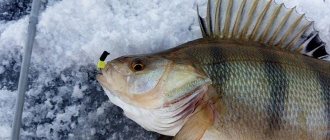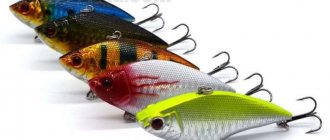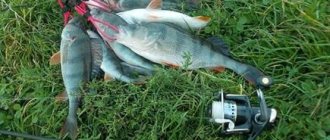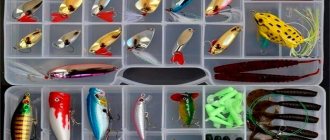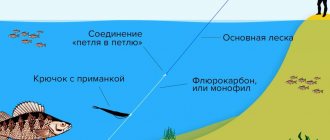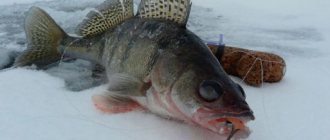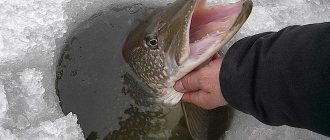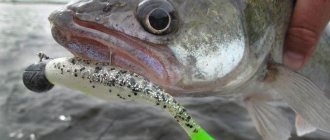How to play as a balancer? What types of balancer wiring are there? What is the difference between bait acting on passive and active fish? You will learn about all this and much more further.
To begin with, we note that predators (perch, pike, pike perch) are most active during periods of first and last ice. Closer to the middle of winter (dead winter), when the amount of oxygen in the water drops, the fish becomes more passive.
Also, the level of activity depends on short-term weather conditions and the characteristics of the reservoir area. But no matter what period you fish, the main task, on the successful completion of which the fishing result depends, is the correct game and choosing a suitable balancer.
Game of balancer on active perch
When obvious fish activity is noticeable, balancers of almost any shape and design are suitable. It is better to give preference to balancers with a wide action in order to fish the entire area under the ice, and not just the vertical column of water under the hole. Balancers with rigid tails will be especially effective in such conditions.
Having drilled the hole, we do not remove the ice crumbs, but immediately lower the balancer to the bottom. Next, we pick up the slack in the fishing line and hold the bait at the bottom for about 10 seconds. At the next stage, you need to play with the balancer, lifting it about 15 cm up and making several small swings with pauses of 5-6 seconds.
Most often, bites are observed precisely during the pause phase. If during the next stroke you feel a fish on the hook for a moment, but there is no bite, you should increase the length of the pauses. You can also try to lightly play with the bait sometimes, but it is important not to overdo it so as not to scare away predators.
Fishing for perch in shallow water along coastal vegetation
Usually the depth in such places does not exceed 1-1.5 meters and it is not possible to make full wiring with every balancer. In such conditions, it is optimal to use a bait up to a maximum of 5 centimeters in length; in the best case, the figure can be reduced to 4. The main selection criterion will be a smooth game, in which the balancer will maximize the area under the hole and create powerful vibrations to attract perch.
In addition to the striped pike, pike may also be interested in the game, so having a leash is simply necessary. However, you should not abuse the power of the material. Everything should be aesthetically pleasing. A fluorocarbon leash with a diameter of up to 0.3 millimeters, or a store-bought tungsten one will be sufficient.
In order to somehow reduce the number of snags on snags, grass and other obstacles underwater, it is better to remove the lower tee from the balancer. In shallow water, this will not greatly affect the number of effective bites. Predators at shallow depths often attack the bait not from below, but from the side.
The average color of a balancer for perch fishing can be used to indicate the color of a perch. Cannibalism in the world of predatory fish is a completely normal phenomenon. However, it is recommended to have other colors with you. External factors (lighting, surrounding vegetation) can quite seriously change the preferences of a predator.
Tips for fisherman: Which balancer for pike perch is better in winter - All the nuances
When fishing in shallow water, you should not clear sludge from the holes. Light penetrating underwater can cause the perch to move away.
It is also better to drill several holes at once. While you are fishing one hole, the fish, frightened by the noise, will calm down at another. And you should behave calmer on the ice. Avoid unnecessary noise.
It’s easier to play snag with a small balancer, creating different wiring options. Its deviation from the axis is often about 20-25 centimeters, which allows it to better avoid obstacles.
Balancers with rigid tail
The monotonous but stable play of the balance beam often attracts the attention of perch and pike perch.
The second method of fishing involves playing a balancer in water at a depth of more than 2 m. Having made 3-5 strokes, it is necessary to reduce the length of the fishing line using a reel by 25-30 cm, and then carry out a new series of strokes at a shallower depth. So gradually playing with a balancer throughout the entire thickness of the water. When the bait reaches the ice, it is lowered back to the bottom and the above steps are repeated. If bites still don’t occur, you should change your fishing location.
Catching perch on a balance beam from ice - gear, tactics and fishing technique
Catching perch on a balance beam from ice is just as popular a form of fishing for striped predators as fishing with a reelless bait.
This trend extends throughout the winter period. From the first ice to the last ice. Even the low winter season does not particularly upset the balancer.
Firstly, the abundance and activity of the striped fish allows the fisherman to “have fun” with soul and body. You just have to find a flock. And the perch always eats.
Secondly, for mastering balancing tackle from ice, there is no better fish like perch. And you don’t need to have a super advanced fishing rod. The main expense is the purchase of bait.
And thirdly, this is my personal opinion; fishing with a balance beam is attractive due to its individuality.
Encampments of “penguins” settled in feeding holes are a ubiquitous phenomenon. Some found the fish themselves, others turned out to be simple “assholes”. Balanced tackle allows you to feel like a real hunter.
I won’t talk about the ease or difficulty of mastering the tackle. When you go out on the ice, you will experience the beauty of fishing yourself. But I assure you that with due diligence, you can proudly raise your head and modestly declare that the fishing was crowned with the capture of a large perch on a balance beam.
What will it take to achieve the result? Set up the tackle, find the fish and master the balancing technique.
The stores have a huge selection of all different winter fishing rods. From expensive sports ones to cheap “Chinese” ones. However, for fishing with a balance beam, you can take a regular one with a handle. In some cases, it is quite reasonable to use a balalaika. The selection criteria are simple:
- Comfortable to hold in hand.
- Ability to withstand frost and periodic impacts on ice.
- It is desirable to have a reel or built-in spool. When fishing with a “filly”, which is also possible, the role of the reel drum is played by the reel.
- A whip with a tulip at the end, or with a nod.
The length of the rod for fishing with a balancer is preferably 30 - 35 centimeters. It is most convenient to work with a rod of this length from the ice. When we talk about wiring, I’ll explain why.
Based on the flexibility of the whip, I formed my own opinion. I will voice it.
I question the advice that the whip should be flexible to dampen the jerks of large fish. The fact is that fishing with a balance beam is not just throwing bait in the water column. It is necessary to control the play of the balancer and eliminate unnecessary, parasitic nodding of the rod tip.
Therefore, it is better to have a short, fast-acting whip equipped with a nod on the fishing rod, rather than a noodle that falls under the dropping of the balancer. Even if the deflections made are insignificant.
Playing with a balancer against a passive predator
When the predator becomes passive, you can try the following method of playing with a balance:
- First, we lower the bait into the water and do not reach the bottom by 5 cm.
- Next, we make 3-4 strokes and pull the balancer up 10-15 cm.
- Again, a few strokes - and we raise the bait a few more centimeters until we reach a meter distance between the balancer and the bottom.
- Then we pause.
- Gradually return the bait back to the bottom, alternating light strokes and lowering by 4-5 cm.
As a rule, such a game is very effective, and the bite most often occurs at the very bottom, so you need to be patient.
In deep winter conditions, a similar method of fishing can also be effective, however, swings in such conditions should be done more smoothly, and it is also worth increasing the duration of pauses. Passive fish are unlikely to chase an overly active bait with a wide action. You will need small balancers with a soft tail, which are characterized by a calmer game, reminiscent of the natural movement of fish.
Soft tail balancers
If the bite is weak, you can turn to another effective technique.
It is necessary to install the balancer so that its hanging hook constantly touches the bottom and thereby raises a cloud of turbidity, which can additionally attract a predator.
We also note that in the dead of winter it can be quite difficult to see a bite from a sluggish fish, so using a nod on a winter fishing rod is highly desirable.
Color, balancer size
The selection of the best balancers with the most attractive colors occurs experimentally, that is, directly on the pond. However, first you should try baits with silver, black, greenish tints, those balancers that are most similar in color to bleak or small perch. If the bite is very weak, you can try balancers with bright, unnatural colors.
The best balancer color for catching trophy perch is an imitation of small perch.
As for the size of baits, they must correspond to the dimensions of the predator’s usual food. For perch, small balancers 3-5 cm long are most often used. If there is a strong current in the area or the fishing depth is too great, larger balancers will be needed. Balancers from 4 cm and above are suitable for pike and pike perch.
How to choose a balancer for perch in winter: criteria
When choosing a bait, you need to pay attention to the length, body shape, weight, color and manufacturer. In order to successfully catch perch of different sizes in different conditions, it is worth collecting an arsenal of balancers, from which you can always choose the appropriate one on a pond, depending on the situation.
This video talks about how to choose balancers for perch and what to look for, and also shows the 4 best models that have been tested in practice:
Size
Size is the parameter that you should pay attention to first. Often this characteristic turns out to be the most important: it happens that changing the bait to a model just 1 cm longer or shorter leads to a dramatic improvement in the bite.
To catch perch in winter, you need to use bait with a length of 20 to 50 mm. It makes sense to use larger ones only when specifically hunting for trophy humpback salmon in water bodies where such fishing is possible. In general, models with a length of 50-80 mm and more are more likely to be pike and zander decoys.
To successfully catch perch with this bait in any conditions - in different bodies of water, at different times, with different fish activity - it is worth acquiring models of different sizes within the range of 2-5 cm. If such an arsenal is at hand, then there is every reason to count on good catch.
Reference! The larger the balancer, the greater the likelihood of catching a decent-sized perch with it. On the other hand, when fishing with large baits, the number of bites decreases, because small stripers, and sometimes also medium-sized fish, prefer to avoid them.
Form
According to their shape, all perch balancers are divided into 2 groups:
- models with narrow, elongated, slanted bodies;
- volumetric baits.
“Fat fish” are well suited for catching stripers, so the emphasis should be on them. Decoys with driven bodies, in turn, are preferable when catching its closest relative - pike perch.
But, of course, there are exceptions to this rule. It often happens that perch is more willing to grab narrow, driven balancers, so it would also be a good idea to add such baits of different sizes to the collection. Likewise, pike perch often willingly grab balance beams of “perch” shapes – with voluminous bodies.
You also need to keep in mind that the choice of bait shape depends not only on the type and mood of the fish, but also on the conditions. Fat balancers are better suited for still water, while narrow, slender models are better for fishing in the current.
Weight
Balancers of small and medium weights are usually used for catching perch. The former are suitable for fishing in shallow waters, the latter – in deeper waters. The most popular bait weights are from 4 to 10 g.
Color
Color is the least important parameter of all the characteristics of blende:
- On the one hand, the perch pays attention to it last: the size and shape of the bait are much more important, as well as the weight, on which the correct game depends.
- On the other hand, tying balancers in the cold is not such an easy task, so changing many balancers in order to try not only different sizes and shapes, but also different colors is quite problematic. In addition, perch preferences in terms of decoy colors can change many times during the day.
- Balancers are used primarily for hunting active perch. And for such fish, the color of the artificial fry, in principle, does not matter much.
Therefore, often anglers experiment little with colors or even refuse such tests, preferring to focus on more important things.
But, of course, the correct coloring of the balancer, like any other perch bait, is quite significant. Replacing a lure of one color with a model of another can lead to a noticeable increase in catch.
It is best to use balancers of natural colors as the main baits - for whitebait or for a small perch. Such a bait will definitely not scare away or alert the minke whale with its color. If you manage to find an active perch in a pond and correctly present it with a natural balancer, a bite is almost guaranteed.
It is also worth adding provocateurs to the naturals - baits of bright, acidic orange, yellow, pink and other similar colors. It is with them that you should alternate balancers of natural colors. Provocateurs are in demand primarily in situations where fish are highly active.
Manufacturers
All perch balancers can be divided into 3 groups:
- cheap;
- mid-price category;
- expensive.
Many people buy baits that are the most affordable and use them to catch minke whales. But such balancers often turn out to be of poor quality - such models do not show an attractive game and only bring disappointment.
It is better to buy a small number of good, proven baits from the middle or high price category. Such balancers will consistently show an attractive game and bring good perch catches in a variety of situations. Excessive savings on the purchase of bait often leads to dismal results.
